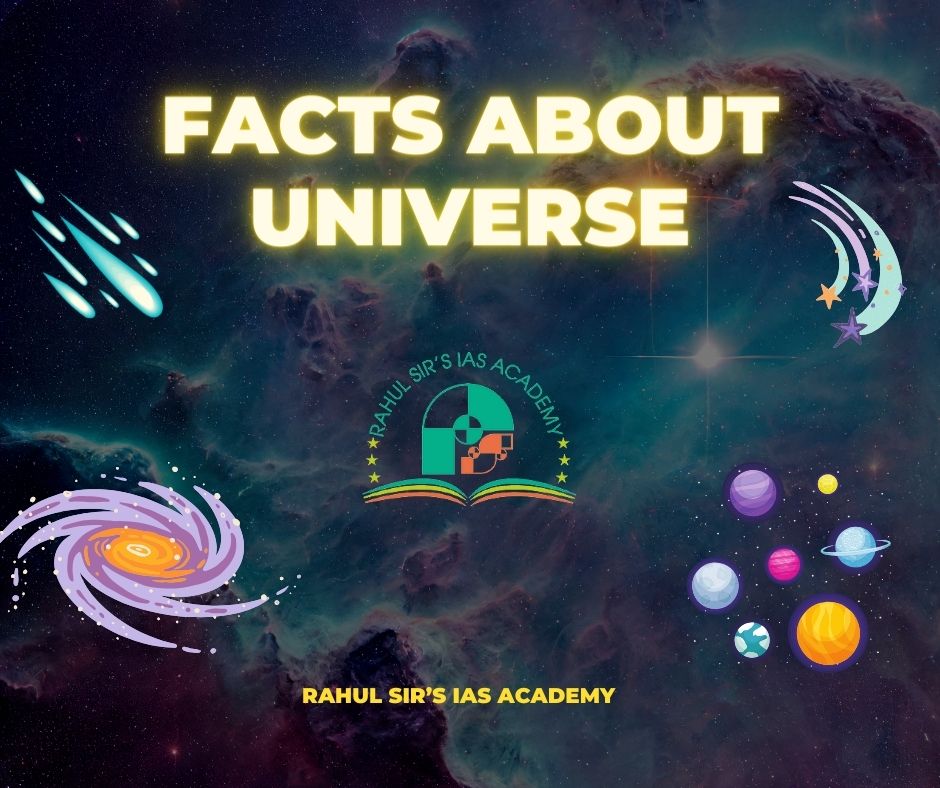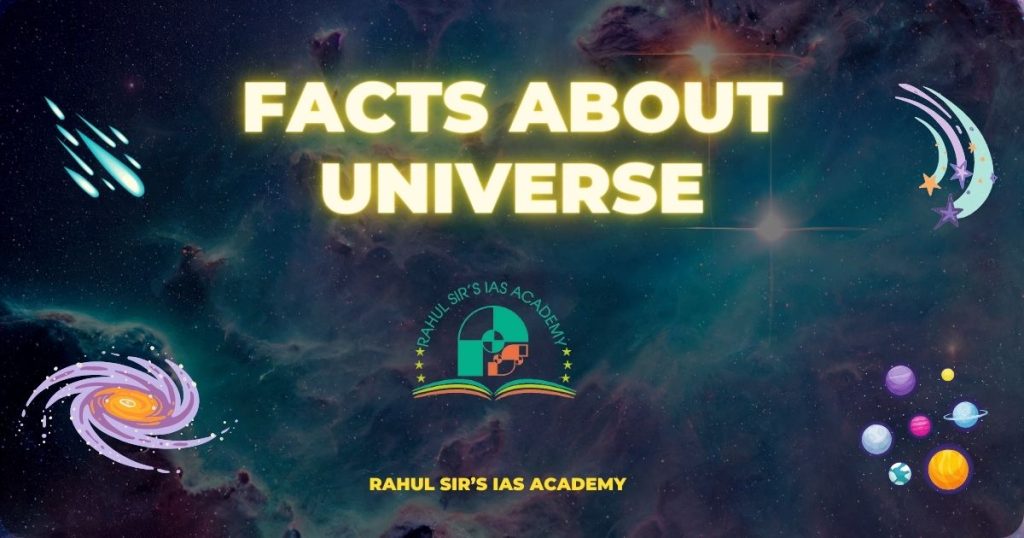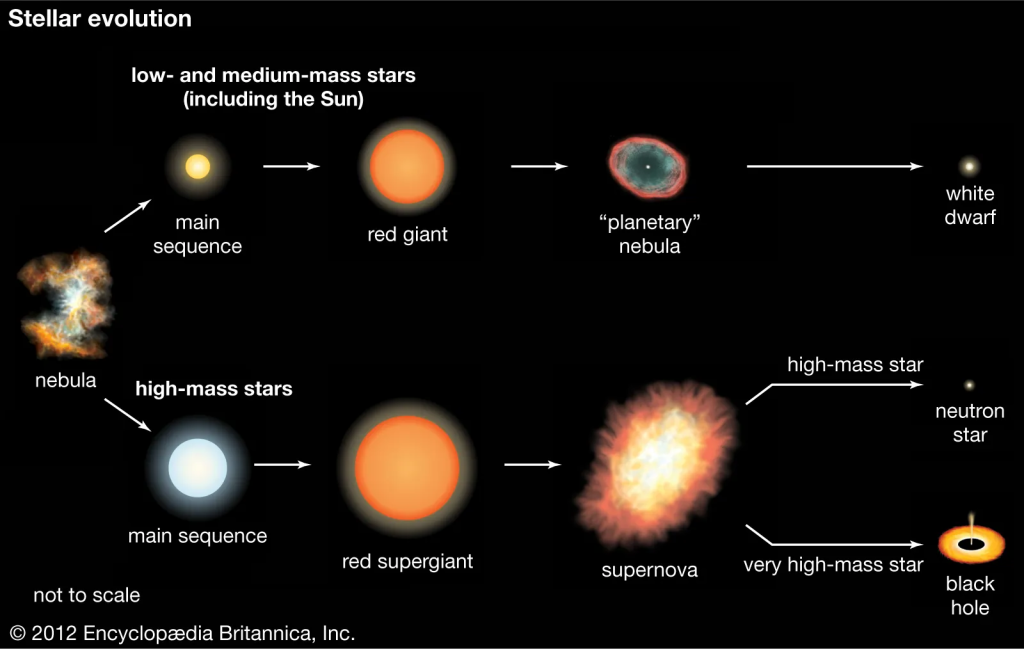
Facts About Universe

Introduction to Facts About Universe
Facts about universe are amazing things to know . Universe is billions of light years in size, and contains hundreds of billions of galaxies, each with hundreds of billions of stars and planets. And it all came from nothing! But :
- What exactly is the universe?
- How did it start?
- And how will it end?
This article explores these questions and more. There are multiple theories about why facts about universe exist and how it came to be. Big Bang Theory is the most popular one of these, and attempts to answer what happened before the universe existed, whilst also giving an idea of how everything in it came to be.
Theories Of Origin Of Universe – Facts About Universe
Big Bang Theory
Big Bang Theory is the most popular theory of the origin of facts about universe initially propounded by Georges Lemaitre. It states that the universe began from a single point, or “singularity”, and has been expanding ever since. The Big Bang occurred about 14 billion years ago, and since then, the universe has continued to expand and cool.
This theory is supported by many pieces of evidence, including the facts that:
- The universe is expanding,
- As well as the presence of background radiation throughout the universe.
- Additionally, scientists have been able to model the expansion of facts about universe and its various properties quite accurately using this theory.
There are some drawbacks to the Big Bang Theory however:
- One issue is that it does not explain what happened before the Big Bang.
- Another is that it cannot account for all of the observed matter in the universe.
Nevertheless, it remains the most widely accepted theory of the origin of facts about universe.
The Steady State Theory

Steady State Theory
The Steady State Theory is the idea that the universe has always existed, and will always exist. This theory was developed in the early 20th century, by British scientists Hermann Bondi, Thomas Gold, and Fred Hoyle, in response to observations that the universe appears to be expanding.
- The Steady State Theory explains this expansion by positing that new matter is constantly being created, to fill in the gaps left behind by the expanding universe.
- In other words the average density of the universe always remains constant.
While the Steady State Theory was once a popular explanation for the origin and evolution of facts about universe, it has since been largely superseded by other theories, such as the Big Bang Theory due to the presence of Cosmic Microwave Background.
The Star Formation Theory

Star Formation Theory
The star formation theory is the most widely accepted theory for the origin of facts about universe. It states that the universe began with a very dense, hot state which eventually cooled and resulted in the formation of the first stars. These stars then went on to form galaxies and everything we see today.
- The star formation theory is based on a number of observational facts, including the fact that we see more young stars in the universe than old stars.
- This is because new stars are constantly being formed, while old stars die out over time.
- Additionally, the distribution of matter in the universe is very uniform, which suggests that it all started from one single point.
- Computer simulations have also been used to support the star formation theory.
- These simulations show how a uniform distribution of matter can lead to the formation of galaxies and other structures we see in the cosmos.
The Pulsating Universe Theory

Pulsating Universe Theory
In 1929, Edwin Hubble made the groundbreaking discovery that the universe was expanding. This led to the development of the Big Bang theory, which posits that the universe began as a singularity (a point with infinite density and temperature) and has been expanding ever since.
While the Big Bang theory is widely accepted by scientists, there is still some debate about what happened before the singularity. One popular theory is the Pulsating Universe Theory, which suggests that the universe goes through cycles of expansion and contraction.
The Pulsating Universe Theory was first proposed by Fred Hoyle in 1948. It was later elaborated on by Martin Rees and George Ellis in 1973. The theory has a number of attractive features, including its ability to explain why the universe is uniform on large scales (a problem for the Big Bang theory).
However, there are also a number of challenges associated with the Pulsating Universe Theory.
- For example, it is difficult to explain how matter could be created in an expanding universe.
- Additionally, recent observations have shown that the universe is not actually expanding at all – it is in fact static or even contracting slightly.
Despite these challenges, the Pulsating Universe Theory remains a popular cosmological model among scientists. It provides a compelling explanation for many of the observed features of facts about universe, and continues to be refined as new data is discovered.
Fundamental Particles – Facts About Universe

Fundamental Particles
In the beginning, there was nothing. No stars, no galaxies, no planets, no atoms…nothing. Then, suddenly, there was a Big Bang—the moment when everything began. That event set in motion the creation of everything we see today: the Universe.
The origin of the Universe is still a mystery to scientists. But they have been able to piece together a pretty good picture of how it all started, based on observations and experiments.
At the heart of it all are fundamental particles—the building blocks of everything in the Universe. These particles are incredibly small and they interact with each other in ways that we don’t fully understand. But they are responsible for everything we see around us.
Fundamental particles come in two types: Quarks and Leptons.
- Quarks make up protons and neutrons, which in turn make up the nuclei of atoms.
- Leptons include electrons, which orbit the nuclei of atoms.
- There are also other types of particles, known as Bosons, which mediate interactions between quarks and leptons.
All of these particles follow the laws of physics. And it is these laws that govern how the Universe behaves.
Higgs Field And Universe – Facts About Universe

Higgs Field
- The Higgs Field is an energy field that gives mass to the fundamental particles.
- Also, the field is everywhere in the Universe. Additionally it comprises of a fundamental particle known as the Higgs Boson (The God Particle), which is used by the field to continuously interact with other particles, such as the electron.
- The particles that pass through the field are given mass and they become heavier. Thus the end result is that they no more travel with the speed of light.
- If the Higgs field did not exist, particles would not have the mass required to attract one another, and would float around freely at the speed of light and no matter would be created. i.e. we would not have existed.
- Particles don’t gain mass by just passing through the ‘Higg’s Field’ for they would violate the law of conservation of mass.
- Finally, Fundamental Particles gain mass by Higgs Field Interactions via Higgs Boson.
- Higgs bosons contain the relative mass in the form of energy and once the field has endowed a formerly massless particle, the particle in question will slow down as it has now become “heavy”.
- The phenomenon is known as the Higgs Effect, which gives mass or energy to a fundamental particle.
- A light photon for instance gains energy and not mass due to Higgs effect because of its wave nature.
- The Large Hadron Collider (LHC) at CERN was built precisely to test the existence of the all illusive Higgs Boson.
- Finally the Higgs Boson was detected in 2012.
How an Atom Was Created? – Facts About Universe

In the beginning, there was nothing. No space, no time, no matter. Then, in a single moment, everything changed. The universe came into existence.
- But how did this happen?
- How did something come from nothing?
The answer may lie in quantum mechanics. According to quantum theory, particles can spontaneously appear and disappear in a vacuum. So perhaps the universe didn’t start with anything at all; it just popped into existence out of the quantum fluctuations of empty space in the form of strings (String Theory)
Of course, this is just a theory. We don’t know for sure how the universe began. But it’s an intriguing possibility that could help explain one of the biggest mysteries in all of cosmology.
In the beginning, there was nothing. No space, no time, no matter. Then, in a single moment, everything changed. The universe came into existence.
- As the universe continued to expand and cool, things began to happen more slowly.
- It took 380,000 years for electrons to be trapped in orbits around nuclei, forming the first atoms. These were mainly helium and hydrogen, which are still by far the most abundant elements in the universe.
- Present observations suggest that the first stars formed from clouds of gas around 150–200 million years after the Big Bang. Heavier atoms such as carbon, oxygen and iron, have since been continuously produced in the hearts of stars and catapulted throughout the universe in spectacular stellar explosions called supernovae.
Life Of A Star – Facts About Universe

Life Of A Star
Stars pass through a definite evolutionary sequence the following manner, depending primarily on their man and internal structure.
- Proto stars: It begins to form by the compression of galactic gas and dust. Compression generates heat which in turn causes Hydrogen ( H2 ) to be convert into Helium In a Nuclear Fusion, thereby emitting large amount of heat and light. A STAR is thus formed.
- Red Giants: Continued Nuclear Fusion over a period of time starts depletion of hydrogen and the Helium core becomes increasingly heavy, resulting into swelling and reddening of outer regions . Such stars of gigantic dimensions are rightly termed as Red Giants. This stage gives the first indication of aging.
- Novae and supernovae : A giant star phase may end in a Novae / Supernovae stage. These are stars whos brightness increases suddenly by ten to twenty magnitudes or more due to a partial or outright explosion in the star. When brightness increases to 20 magnitudes or more, it is called a Supernova.
Next Stage
- White Dwarfs: Novae / Supernovae explosion in a small star like our sun ( star lighter than 1.2 solar mass ) may leave behind a very dense core of that star . A star of this size cools and contracts to become a White Dwarf, which is no bigger than the earth, but having central density up to 108 gram/cm3.
- Neutron star : A supernovae explosion in a star bigger than the sun but not more than twice as big , may leave behind an extremely dense , residual core of that star, reaching a density of 1014 grams/cm3 known as Neutron star. At this stage the pressure is so high that the Hydrogen electrons collapse on the protons and what remains is only Neutrons which also happens to be a state of matter.
- Pulsars: Because of small size, Neutron star rotates very speedily. Such fast rotating Neutron Stars emitting radio waves in regular frequency are called pulsars.
- Black Holes: Stars having mass greater than three times that of the sun, because of their great gravitational power, have contracted so much that they have developed super density of 1016 grams/cm3 . It is so dense that nothing, not even light can escape from its gravity and hence called Black Hole.
CELESTIAL BODIES
Galaxies

A galaxy is a huge congregation of millions of stars held together by its own gravitational field. On structural analysis, three basic types of galaxies have been identified:
- Spiral galaxies: Greater concentration of stars in the centre, old ones near the centre and youngers in the arms. Our galaxy, the Milkyway and Andromeda are examples of spiral galaxies.
- Elliptical galaxies: The most numerous ( about 2/3 of all galaxies) consists of very old stars.
- Irregular galaxies: Comprise about 1/10 of all galaxies, mostly young stars.
- The two nearest galaxies to our milky way are the large Magellanic cloud and the small Magellanic cloud. Our galaxy, the Milky Way and the Andromeda galaxy are the two largest galaxies in a cluster of some 23 galaxies , known as the local group.
Nebulae:

These are distant stellar system of luminous bodies made up of gas and dust particles. It is this place where Proto Stars are created. ORION Nebula is situated in the Milky Way.
Constellations:

These are clusters of stars , organised into distinct shapes and figures and named accordingly. Hydra is the largest constellation.
Comets:

There are huge clouds of frozen gases and dust which have their home in the outer fringes of the solar system. Their head (also called CDMA if it has no tail ) is formed by the evaporation of solid ice particles when the correct approaches the sun. They have an extremely eccentric orbit but a definite periodicity, as the Hally’s comet is sets every 76 years. The tail is always away from the sun.
Meteors

These are small solid matters which, when coming into the atmosphere of the earth , burn out due to friction . When burning, they emit light and hence called shooting start.
Leonid shower is a meteor storm, originated in the constellation Leo. These meteors are actually part of comet temple- turtle and they fall on every 33 years.
Quasars or Quasi Radio Source

In the universe, some matters appear small but emit more energy than the stars of the milky way. Such stars are called Quasars. Such extremely luminous celestial bodies were discovered in 1961
Dark Energy And Universe

- Dark Energy is the mysterious force that is making the universe expand. By 1990s, astronomers had concluded that the universe is expanding.
- But theoretically the universe must start collapsing into itself with the increase in gravity as new matter is constantly getting created.
- This phenomenon was named the Big Crunch.
- However, in 1998 The Hubble Space Telescope sent some images of Supernovae, which proved that the universe is expanding at faster rate than earlier.
- So the question is what is instrumental in this phenomenon ? The only plausible explanation is the Dark Energy.
- Thus since the 1990s, Dark energy has been the most accepted premise to account for the accelerated expansion. Although unknown, but astronomers were able to calculate that roughly 68 % of the universe is Dark Energy, 27 % Dark Matter and what we know as matter from all our instruments is just 5 %.
Some Explanations
- According to Albert Einstein, Dark Energy is the property of Space as it is possible for more space to come into existence.
- Again Einstein’s theory of gravity gives us the concept of Cosmological Constant, which suggests that the empty space can possess its own energy. As the Dark energy is the property of space itself, it would not get diluted as the space expands. And with more space more energy would come into existence. As a result, this form of energy would cause the universe to expand faster and faster.
- The quantum theory suggests that empty space is full of temporary particles that constantly appear and disappear. But the calculated energy gave some bizarre results.
- ‘Quintessence’ – Suggests dark energy a new kind of dynamical energy fluid or field, something that fills all of space but something whose effect on the expansion of the universe is the opposite of that of matter and normal energy.
Dark Matter

- Astronomical observations have shown that the galaxies in the universe are rotating at enormous speeds.
- But calculations reveal that it is impossible for the gravity created by the observable matter to hold these galaxies intact.
- They should’ve been ripped apart long ago. So what holds them intact? This question led us to believe that there has to be some extra matter which is invisible.
- This mysterious matter is called the Dark Matter.
- Unlike normal matter, dark matter does not interact with the electromagnetic force which means it does not absorb, reflect, or emit any electro-magnatic radiation and is, therefore, difficult to detect.
- Thus, so far we are much more certain what dark matter is not than we are what it is.
See Also
OUR SOLAR SYSTEM – At A Glance
The Atmosphere – Structure And Composition
Hydrosphere – Everything you want to know
FAQs
What is called facts about universe?
It is the sum total of all the known matter. It is also known as Cosmos.
What exactly is facts about universe made of?
Universe is made up of dark energy, dark matter, ordinary matter, electro magnetic radiation and antimatter.
What is beyond facts about universe?
Universe began with the big bang 13.8 billion years ago and with it space and time also began. So there is nothing beyond the universe and we can simply assume that it is expanding into itself.

